Nesting Crocodiles and Hatchlings
Join us in beautiful South Florida for the nesting season of the endangered American crocodile. Southern Florida is home to the northern most population of American crocodiles. The Florida population was declared endangered in 1975, primarily due to habitat loss from a growing human population. In an ongoing effort to monitor the health of the Florida population, surveys for nests are conducted by boat, foot and from the air from March through May when nests are constructed. Nests are monitored using these same methods through August, the end of the hatching season. We document the fate of each nest and attempt to catch as many hatchlings as possible. Once captured, hatchings are measured, weighed and given a unique identification mark.

Searching by Air and Boat
We begin by flying the shoreline along the southern tip of Florida looking for disturbances in the sand. Crocodiles dig holes 'testing' for the ideal spot to build their nest. These disturbed locations are more easily visible from the air. Once these sites are spotted, we mark them with a GPS. Nests are always located near to the water, although usually above the high water mark to avoid drowning due to tide or seasonal fluctuations from rain. In remote areas where high activity is observed we land to investigate and determine the probability of a nest site. In areas that are easily accessible we return by boat to investigate further. The more detail we record now, the easier it is to monitor the sites later in the season.
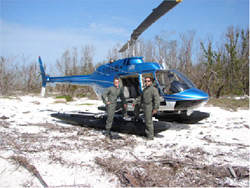
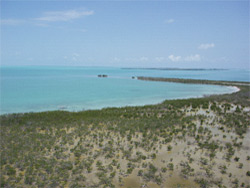
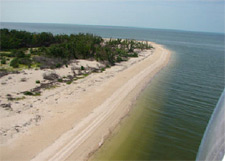 |
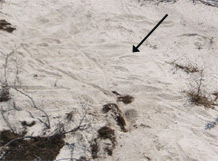 |
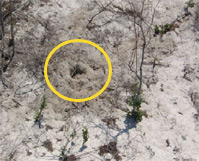 |
Further Investigation
We search the shoreline on foot looking for nesting activity such as tail drags, digging, presence of eggs or shells and areas of other activity in the sand. We go out at least twice a week to keep a close eye on progress and to find additional activity not present during our last visit or during our previous flight survey.
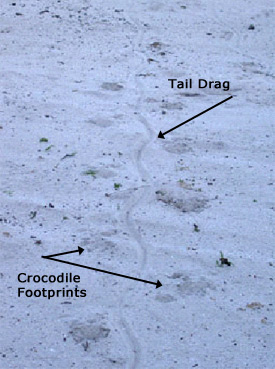

Nests
Although the majority of American crocodiles in Florida Bay deposit their eggs within holes, some individuals build mound nests. In Florida Bay, the majority of nests are hole nests, with a few mound nests located mainly on islands. A single female typically lays a clutch of between 30 and 60 eggs that incubate for 80 and 90 days. Temperatures of the nest during a period of incubation determine the sex of the hatchling crocodiles. Raccoons are the dominant natural predator of crocodile nests in Florida and are responsible for a few to many nest failures each year (image above). A female crocodile constructs a maximum of one nest per year and can nest as often as every year or every couple of years, depending upon her health and condition. She can build her nest away from others, or a single site can contain several nests in close proximity to each other.
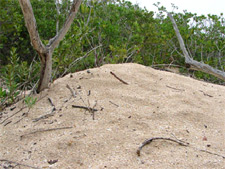 |
 |
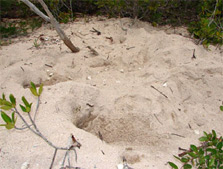 |
Hatching
Once nests begin to hatch we go out every night searching for hatchlings. When shone with a spotlight crocodiles' eyes shine or glow red, even tiny hatchlings. We can often locate active nest sites or crèches of hatchlings through the eye shine of the mother, usually close by in the water. If you spot one little hatchling you are bound to spot more.

Unlike with sea turtles, hatchling crocodiles cannot dig their way out of the nest. They are dependent on mom to open the nest up. Once opened, the young can crawl out on their own or mom gives them a ride to water. Mom can also carry her babies anywhere from a meter ot kilometers from the nest to protected nursery habitat.
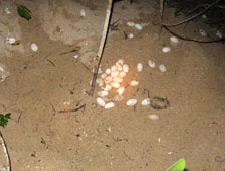 |
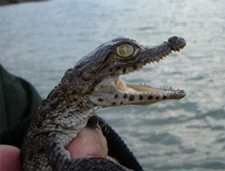 |
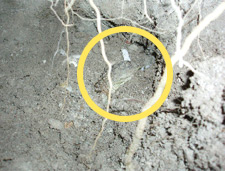 |
Mangroves provide ideal hiding places for newly hatched crocodiles.
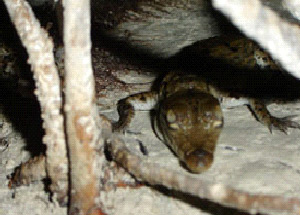

Catch, Weigh, Measure
Now that we have found their location - we have to go about catching them, this is done by hand or with pilstrom tongs which give you a little extra reach. If a nest is found with a large number of hatchlings, they are all collected at once and placed in a bucket or cooler to be measured. We record weight, length and give each animal an individual identification mark. This is all part of an ongoing mark recapture program for the American crocodile to monitor the health, growth and survival of the population in Florida. Every year for the past 10 years the number of nests and hatchlings found in southern Florida has been increasing, indicating the Florida population of American crocodiles is gradually starting to recover.
 |
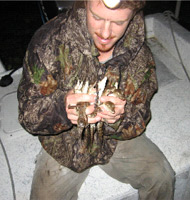
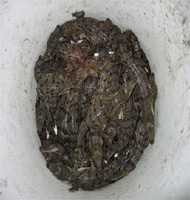
|
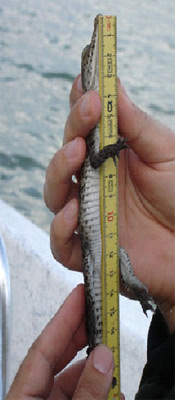 |




